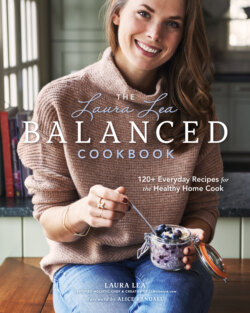Читать книгу The Laura Lea Balanced Cookbook - Laura Lea - Страница 42
На сайте Литреса книга снята с продажи.
ОглавлениеOTHER:
• Baking powder
• Baking soda
• Vanilla extract
• Almond extract
• Maple extract
• Arrowroot starch* or non-GMO cornstarch
• Dark chocolate and/or semi-sweet
chocolate chips
• Cacao nibs
• Cocoa powder: There are three different
chocolate powders out there. Raw cacao
powder is made by cold-pressing raw cocoa
beans. This is the most “natural” form, and
it is extremely high in antioxidants. Natural
cocoa powder is made by roasting cocoa
beans at high temperatures, which decreases
the nutritional content. Dutch process
cocoa powder is natural cocoa powder that
has been alkalized to become less acidic
and astringent-tasting. The latter two still
provide health benefits, however, and they are
preferable for baking, as the baking process
negates the point of having raw cacao.
Cutting to the chase—I keep natural cocoa
powder around, and I use it anywhere I’d need
a chocolatey powder. If you want to amp up
your nutrient game, however, feel free to also
use raw cacao in smoothies or no-bake treats.
SOME FUNKY INGREDIENTS
AND OTHER WAYS TO USE THEM
The vast majority of the ingredients in this
book can be found in any grocery store and
probably already sound familiar to you. This
is how I cook—simply and from the same
basic pantry—and it makes life so much
easier. That said, there are a handful of
ingredients you’ll see scattered throughout
that you might not recognize. If you choose
not to buy a single one of these items, you
can still make most of my recipes. However,
I recommend them. These are ingredients
that have enhanced my cooking with their
flavor and nutrition, and often take the place
of less healthy foods. I believe they’re worth
the investment, and your body and tummy
will thank you! Let me tell you a little bit about
each, and why I think they’re worthy of a spot
in your pantry.
Extra-virgin organic coconut oil: Coconut oil
has been a superstar on the health-food scene,
touted for having countless miraculous and
healing properties. While I don’t think it’s the
panacea it has been blown up to be, unrefined
organic coconut oil is an extremely nutrient-
dense food. The monounsaturated fatty acids
in coconut are anti-inflammatory, and they’re
used immediately by our body for energy
instead of being stored first, as other fats are.
One specific fatty acid called lauric acid has
antiviral, antibacterial properties, which can
benefit our immune system in helping fight
pathogens. Plus, it’s a great alternative to olive
oil and butter in cooking, as it lends a lovely,
mild coconut flavor to food.
Other uses: Topically, coconut oil can be
a great body moisturizer for your skin—
test a small amount to ensure there’s no
negative reaction.
Where to find: Most grocery stores, Whole
Foods, The Fresh Market, Trader Joe’s,
Amazon, Vitacost, Thrive Market
Toasted sesame oil: Oh, how I love toasted
sesame oil! It has the most wonderful nutty
flavor. You only need a small amount to create
that signature taste found in many Asian
cuisines. There really is no good substitution
for it, but know that one bottle lasts for a very
long time. On the health front, sesame seeds
